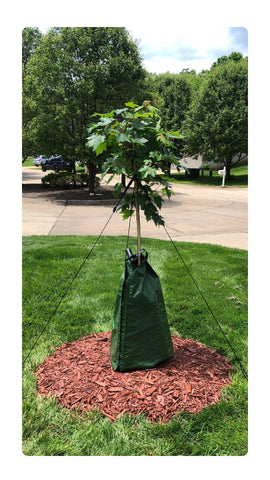
Maximizing Tree Health: The Role of Fertilizers & Tree Stakes
As we embark on another planting season, it is necessary to delve into the essentials of nurturing trees for their optimal growth and longevity. While the act of planting involves much more than just digging a hole and placing the tree in it, we should focus on two key elements to enhance a newly planted tree’s success: fertilizers and tree stakes.
Fertilizers: Nourishing the Roots
Think of fertilizers as the multivitamins for your trees. Just like us, trees require a balanced diet to thrive. While soil naturally contains some essential nutrients, it might not always provide everything a newly planted tree needs, especially in urban environments or areas with poor soil quality.
Fertilizers supplement the soil with vital nutrients like nitrogen, phosphorus, and potassium, which are essential for healthy root development, robust foliage, and overall growth. Nitrogen aids in leaf and stem growth, phosphorus stimulates root development, and potassium strengthens the tree's resistance to diseases and environmental stresses.
When selecting fertilizers, opt for slow-release or organic options. Slow-release fertilizers provide a steady supply of nutrients over an extended period, ensuring sustained growth without the risk of nutrient leaching. Organic fertilizers, derived from natural sources like compost or animal manure, improve soil structure and promote microbial activity, fostering a healthy ecosystem around the tree's roots.
We have had our best results with Bio-tone organic starter fertilizer from Espoma. Bio-tone has been proven to increase the root mass of newly planted trees and shrubs. This helps ensure that new plantings get maximum water and nutrients from the soil to minimize transplant loss. Because it is organic, you can rest assured that you will not burn the young roots.
Remember, moderation is essential when using non-organic or chemical fertilizers. Over-application can lead to nutrient imbalances, root burn, or environmental pollution. Always follow the manufacturer's instructions on all fertilizers and consider soil tests to tailor your fertilization regimen to the tree's specific needs.

Tree Stakes: Anchoring Stability
Just as toddlers require support while learning to walk, young trees benefit from a helping hand in their early years. Tree stakes serve as crutches, providing stability and preventing the sapling from swaying excessively in the wind or being uprooted by external forces.
Properly installed tree stakes anchor the tree's root ball, allowing the roots to establish themselves securely in the soil without the risk of toppling over. This is particularly crucial for taller or top-heavy species prone to wind damage.

When staking a tree, aim for a balance between support and freedom. Avoid over-tightening the ties, as this can restrict the tree's natural movement and impede its growth. Regularly inspect the stakes to ensure they remain intact and adjust them as the tree matures and gains strength. Our Tree Staking Kit by Dewiit provides everything you need to stake your newly planted tree. The non-girdling wraps ensure no damage to the bark when using this product.

It's worth noting that not all trees require staking. Smaller or shorter trees, such as evergreen trees that are 2.5 feet or shorter, may fare well without additional support. Assess the tree's size, structure, and environmental conditions before deciding whether staking is necessary.
Generally speaking, trees only need to be staked during the first 18 to 24 months after planting, and in most cases, the stakes are removed after one year.
Watering Bags: The Perfect Way to Water
Tree watering bags are an effective tool for nurturing newly planted trees in the landscape, offering a convenient and efficient way to provide consistent hydration during critical establishment periods.
These bags typically consist of durable materials like polyethylene or PVC, designed to hold and slowly release water directly to the tree's root zone over an extended period. This controlled hydration helps reduce the stress often experienced by newly transplanted trees, promoting healthier root development and overall growth. By delivering water directly to the root zone, watering bags reduce water waste compared to traditional methods like sprinklers or hoses, as they minimize runoff and evaporation.
One significant advantage of watering bags is their ease of use and low maintenance requirements. Once filled, these bags can provide hydration for several days, depending on the tree's size and environmental conditions. This makes them particularly beneficial for busy homeowners who may not have the time to water trees manually on a frequent basis.
Additionally, the slow-release nature of watering bags ensures that moisture penetrates deeply into the soil, encouraging roots to grow downwards in search of water, which contributes to the tree's long-term stability and resilience.
Shop Tree Care Necessities Online
In conclusion, fertilizers, watering bags, and tree stakes play pivotal roles in nurturing young trees and fostering their growth into majestic specimens that enrich our landscapes and ecosystems. Providing the proper nutrients, hydration, and support will set the stage for your investment's flourishing and green future.
